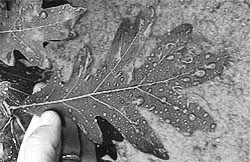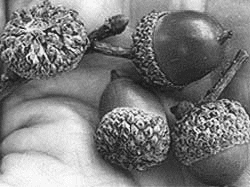Green Horizons
Volume 15, Number 4Fall 2011
Hank Stelzer, MU Forestry Extension
Note: This is a new GH series designed to acquaint forest landowners with those tree species they are most likely to encounter in their woodlands. We will kick off the series with one of the most common Midwestern species, white oak.
White oak (Quercus alba) is an outstanding tree among all trees and is widespread across eastern North America. Its high-grade wood is useful for many things, an important one being staves for barrels. The acorns are an important food for many kinds of wildlife.
 |
| A white oak leaf is widest above the middle with 6 to 10 rounded lobes. |
White oak is a large tree, up to 120 feet tall, with a long, straight trunk, and a broad, rounded crown. Leaves are alternately arranged on the twig, and are 5 to 9 inches long and 2 to 4 inches wide (usually widest above the middle) with 6 to 10 lobes with rounded tips. The upper leaf surface is bright green and the lower surface is whitened lacking hairs. The fruit is an acorn ¾ to 1 inch long, with a cup covering up to ¼ of the nut; cup scales numerous and warty.
Mineral nutrition is not limiting to white oak growth except on verysandy soils where moisture is also a limiting factor. White oak has the ability to grow on all upland aspects and slope positions within its range except extremely dry, shallow-soil ridges; poorly drained flats; and wet bottom land. It grows best on north and east-facing lower slopes and coves and grows well on moderately dry slopes and ridges with shallow soils. White oak is more abundant, although smaller in size, on the drier west- and south-facing slopes than on the more moist sites.
 |
| White oak acorns are ¾ to 1 inch long with a warty cup enclosing about ¼ of the acorn. |
White oak grows in association with many other trees, the more important of which are other upland oaks, hickories, yellow-poplar, American basswood, white ash, sweetgum, blackgum, sugar maple, shortleaf pine, loblolly pine and eastern white pine. The most frequent associates are other oaks and the hickories.
White oak can produce seeds prolifically, but good acorn crops are irregular and occur only every 4 to 10 years. Sometimes several years may pass without a crop. This great variation in acorn production exists not only among isolated stands of oaks but also among individual trees within stands and from year to year. Seeds germinate in the fall soon after dropping, requiring no pretreatment for germination.
Small white oak trees sprout prolifically and vigorously when cut or damaged by fire. The ability to sprout depends on the d.b.h. of the parent tree. One can expect 80 percent sprouting if the tree diameter ranges from 2 to 5 inches; 50 percent of trees 6 to 11 inches in diameter will sprout; and only 15 percent sprouting will be observed if tree diameters are 12 to 16 inches.
White oak is generally classed as intermediate in tolerance to shade. It is most tolerant in youth and becomes less tolerant as the tree becomes larger. White oak seedlings, saplings, and even pole-size trees are nevertheless able to persist under a forest canopy for more than 90 years.
Saplings and pole-size trees respond well to release. Other things being equal, however, the trees to release should be the large potential crop trees that show evidence of rapid recent growth.
For more information on white oak, as well as other common forest tree species, here are three excellent reference guides:
-
Trees of Missouri Field Guide by Don Kurz. Missouri
Department of Conservation. $7.50
www.mdcnatureshop.com
Trees of Missouri by Carl Settergren and R. E. McDermott.
University of Missouri Extension Publication SB-767.
$8.00 www.extension.missouri.edu/publications
A Key to Missouri Trees in Winter by Jerry Cliburn andGinny Wallace.
$3.00 www.mdcnatureshop.com